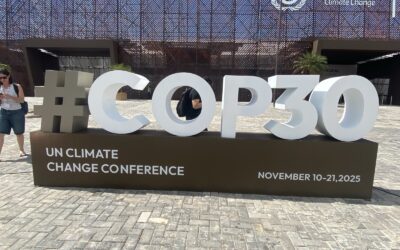The IMO Should Listen to Outcry Over False “Green” Bioenergy Solution
Bioenergy, including crop-based biofuel, is often portrayed as “low-carbon,” but it isn’t, and the global shipping authority must recognize this. Otherwise, the ships delivering our goods could soon be fuelling deforestation and human rights violations.
By Megan Morrissey, Global Forest Coalition
A shorter version of this op-ed was published in Context, a publication of Thomson Reuters Foundation on March 5, 2025
As consumers, we don’t know much—or really think much—about shipping. Why should we? Logically, we know that shipping makes possible a lot of life’s conveniences. Wine from New Zealand sipped in New York? Chinese-made toys under the Christmas tree? The steel I-beams in a roof? We don’t need to worry about how it all got here.
But when you get a glimpse of this world, it easily fascinates. A book called Ninety Percent of Everything by journalist Rose George opened my eyes to just how big the world of big shipping is and what it’s like aboard the massive boats with tiny crews who usually don’t know what’s inside the shipping containers they’re moving.
There’s a lot of darkness out there on the high seas, both literal and figurative. I learned that red light doesn’t “wake up” the eyes, so crews use it to look around on deck at night without compromising their vision. Marine transport is a dangerous business, to say nothing of the terrible working conditions faced by its low-wage laborers.
And then there’s the question of what powers the hulking vessels that carry ninety percent of everything we consume. It’s fossil fuels, historically. The shipping industry consumes 5% of global oil production and is responsible for 1 billion tonnes of annual emissions—3% of global emissions—the same as big economies such as Germany or Japan.
Now, the UN’s shipping regulator, the International Maritime Organization is debating ways to “decarbonize” the industry. Sadly, they’re talking about relying on biofuels, an energy source that has been portrayed as a “green” or “clean” option but really isn’t.
The harmful impacts of bioenergy aren’t just related to its carbon emissions, which rival those of oil and gas. In addition, bioenergy production, including crop-based liquid biofuels, is linked to land and water grabbing, loss of food sovereignty, threats to food security, and widespread ecological harm.
The IMO’s Global Fuel Standard, part of a historic target to transition shipping to a net zero scenario by around 2050 that was debated this month in London, could either phase out fossil fuel and promote the uptake of sustainable fuels and embrace energy savings, or explode demand for destructive biofuels, threatening food security, biodiversity, and forests.
This is a scenario that has played out before in the heat and power industry, an example we can learn from.
Bioenergy from trees for heat and power, a proven disaster
Where I live in North Carolina, we’re proud of our longleaf pines, a beloved state symbol. They used to be used to make the tallest ship’s masts. These days, they’re logged and turned into wood chips or pellets that are burned up as “biofuels” for heat and electricity. Some big pine trunks are processed locally by companies like Enviva, polluting the air in some of the poorest towns in our state, and others are sent to Europe to power plants like Drax.
In a climate change crisis, we count on forests and land to act as “carbon sinks,” absorbing the harmful emissions that countries around the world keep throwing into the atmosphere despite thirty years of international negotiations and promises.
Governments and corporations know that persistent high emissions are the problem, but instead, perform the creative accounting of carbon credits that allow powerful players to pay to pollute in one location with the promise of conservation—frequently dispossessing locals—in another. Whether fossil fuels or biomass, it all has to come from somewhere, and as usual, those least responsible for causing the climate mess are the ones forced to deal with its repercussions.
Bioenergy from crops, an emerging disaster
Wood for pellets is one example of how forests and land are being gobbled up for heat and power, and it has been a proven disaster. Another nefarious one is biofuels from crops like soybean and palm oil, which is what the shipping industry is now targeting. This has caused a major outcry among civil society organizations who realize the ills of biodiesel are at least on par with those of oil and gas.
These groups were joined by shipping companies, including the German shipping giant Hapag-Lloyd, who called for the exclusion of crop-based biofuels from IMO’s list of green alternatives to traditional fossil fuels.
The call came after a proposal by Brazil last year that promoted biofuels as a long-term solution to power shipping. Brazil, the world’s second-largest biofuel producer after the United States, is already facing the consequences of crop-based biofuel expansion such as oil palm, soy, and maize. Recent studies show increased deforestation rates, rising food prices, and the conversion of forestlands for biofuel cultivation.
By 2030, most biofuels could come from palm and soy, with almost 300 million bottles of vegetable oil diverted to powering ships every day, a scenario with major consequences for the environment and people if the IMO opts for deforestation-linked biofuels. Advanced biofuels derived from residues and waste won’t meet the demand of such a large market due to their scarcity, limited scalability, and connection with fraud risk.
Biofuel takes up fertile land that could be used to feed populations who are struggling with food security, including on territories of Indigenous Peoples and local communities who are often pushed off their land and criminalized. It’s inefficient to take rainforests, clearcut them, and plant and harvest monocultures to turn them into fuel. It’s a lose-lose for the climate, the environment, and for food production in an overheating world.
Food- and feed-based biofuels are also linked to deforestation, an urgent problem in the Amazon and in many of the world’s tropical forests, which are homes and habitats as well as carbon sinks.
An open letter signed by about 70 groups states: “Communities in many countries of the global South, including Colombia, Brazil, Paraguay, Argentina, Indonesia, Malaysia or Cameroon, are already facing the consequences of vast and rapidly expanding monoculture plantations of oil palm, soy and other crops in demand for biofuels. This has devastating impacts on small farmers and indigenous communities, including effects on health due to the intense use of pesticides. We do not want to witness what could happen in those countries if biofuel production should escalate [for] international shipping.”
Let’s not repeat the biofuels blunder
The IMO has until April at its MPEC 83 meeting to wrap up negotiations on pathways to decarbonize their industry. This group and its 176 member states—including Brazil, which will host UN Climate COP30 this year—would be wise to rule out the use of biofuels for shipping, as civil society groups around the world are urging them to do.
As the groups point out, gobbling up cropland to produce biodiesel is not the way to decarbonize shipping operations. There are better and more sustainable options, for example: “Improved energy efficiency through stricter standards and innovative ship designs, and the adoption of advanced propulsion technologies like wind assistance.”
The longleaf pines, like the jungles of Brazil and forests around the world, are worth a lot more standing than they are burned up for temporary gain.




